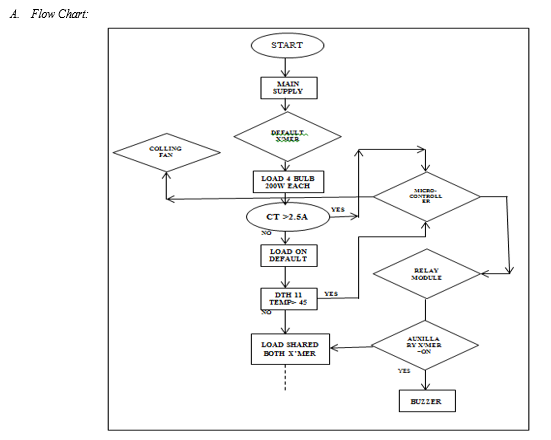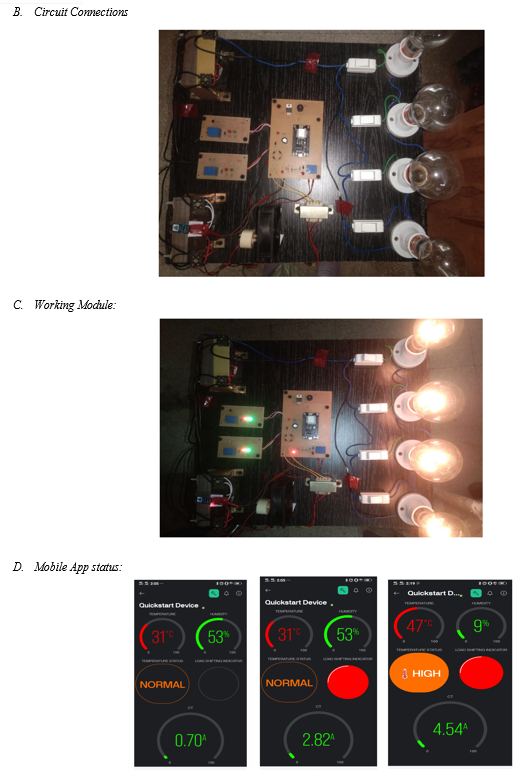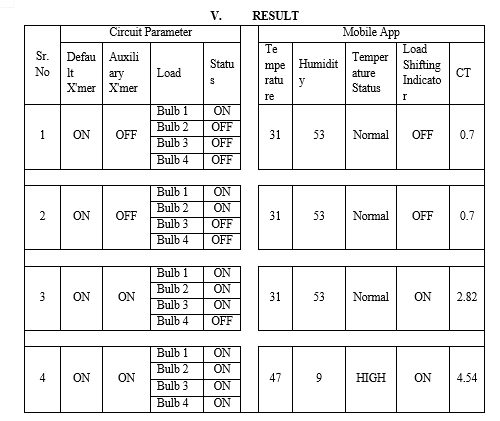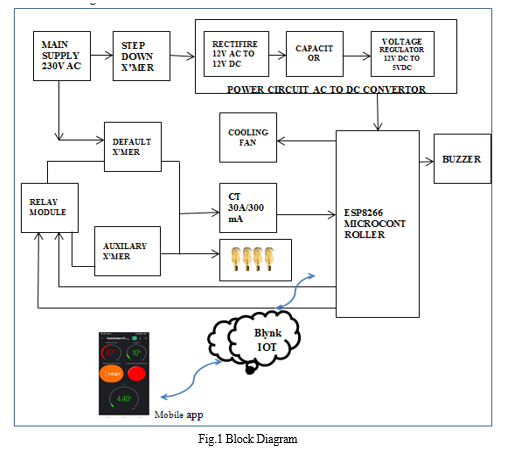Ijraset Journal For Research in Applied Science and Engineering Technology
- Home / Ijraset
- On This Page
- Abstract
- Introduction
- Conclusion
- References
- Copyright
Automatic Load Sharing of Distribution Transformer (IOT)
Authors: V.N Chatse, G. D. Shingade
DOI Link: https://doi.org/10.22214/ijraset.2024.63458
Certificate: View Certificate
Abstract
As we have move in new Era of AI, automation & innovative infrastructures that leads to escalate the demand for power exponentially over the last century. Also increased population is the major reason in demand growth. Automatic Load sharing of Distribution Transformer, using IOT One of the method through which today’s energy crisis like power demand and protection of Transformer ultimately Protection of Distribution system can be addressed. The primary goal of load division is to shield the transformer from overloading. Due to overloading the effectiveness of the transformer decreases as a result frequent power failure occurred, the winding become overheated and may be burned. As a result the transformer failure rate increases. And replacement of transformer with new one is the major task, it require huge money and man power. Protection of Distribution from overloading, maintain reliable power supply to Industry and household is the key assignment to handle to Distribution Company. Automatic Load sharing is one of the best solution, this will be accomplished by using a microcontroller. Two Distribution Transforms are connected through parallel including the active role of Microcontroller. The load on the first transformer is compared to a reference value by the microcontroller. When the load exceeds the reference value, the additional load is shared by the second transformer.
Introduction
I. INTRODUCTION
The prime motive of a Automatic Load sharing of Distribution transformer is to shield it from Overloading then to facilitate reliable power supply to Industrial, commercial & Residential Pocket. In India Even at AI Era the major challenge faced by power distribution sector is continuous power failure owing to overloading, follows the Man & Money loss to distribution sector as well to power beneficiaries. Automatic Load sharing of Distribution Transformer (IOT) facilitating below features,
Automatic Load sharing of Distribution Transformer (IOT) revolve around enhancing the efficiency, reliability, and safety of power distribution systems.
Protects the infrastructure, optimizes operations and supports modern energy management practices. By leveraging real-time monitoring, data analytics, and automated control, IOT- based load sharing.
Protects transformers from overload and related issues, also enhances the overall performance of the power grid.
II. SYSTEM DEVELOPMENT
The proposed Automatic Load sharing of Distribution Transformer (IOT) module integrates Transformer, advanced Electronic circuit (Micro controller), sensors, with IoT (Cloud & App) connectivity, and data analytics to enable real-time energy monitoring, intelligent load management, and energy efficiency improvements. The Microcontroller get data from CT & DTH Sensor, which are transmitted wirelessly to a central monitoring system, By utilizing IOT connectivity. This module empowers operator to access Distribution Transformer status remotely via mobile applications or web portals. And it will leads to optimize the life of transformer, curtail expenses over repairing of transformer, and pleased industrial & household Electricity consumers ultimately take share in healthy national growth.
III. BLOCK DIAGRAM
IV. WORKING
The current module purpose is to automatic share the load of Default transformer by using Auxiliary Transformer and real-time monitoring system with the help of IOT.
System Module circuit consist of hard ware components like Transformer (Three in Nos), Power Circuit, Relay Module, Micro Controller WI FI Unit, Temperature Sensor DHT11, Current sensing unit, indication system (LED, Buzzer), Cooling system, Mobile App (IOT Cloud), Load, 4 switches etc.
And in Software part Arduino IDE (Integrated Development Environment) application, Blynk App (in Mobile),
For successfully implementation of this module we have to place the components at their proper places. In this module we are using the Parallel operation of transformers for this, we have connected the Two transformers i.e Default Transformer & the Auxiliary Transformer in parallel by making Primary of both the transformer common with placing relay module between the Primary. And at the secondary side, secondary made common by placing Current transformer between them to measure the load current. The placing of Current & the relay is important to switch on the auxiliary transformer & get it in to the operation. As the Microcontroller is operated on 5V DC take the benefit from Power circuit which convert the 12V AC to 5V DC, which will help to operate the Microcontroller unit & all the electronic equipment’s situated at this module.
Main components used,
Default Transformer (230V /110V ),
Auxiliary Transformer (230V/110V),
Power Circuit- (Step Down Transformer (230V/ 12V), Bridge Rectifier (to 12V AC to 12V DC), Capacitor, Voltage Regulator (12V DC to 5V DC).
Relay Module (Two Relay ), Current Transformer (30A /300mA),
Micro Controller ESP8266,
Temperature Sensor DHT11,
Buzzer, Cooling Fan,
Mobile App, Cloud (IOT),
4 Bulb (200Watt each) as a load, 4 switches etc.
Subsequently placing all above units at their proper places we can complete the circuit by connecting all the components & programming of NOD MCU WiFi module. Our circuit is ready for the operation. After switching on the power supply First Default circuit is get the power, and gradually if we gradually increase the load i.e first Bulb & then second bulb switch ON, mobile app indicate normal status of current, Temp, Humidity & Load shift parameter. After switching on the Third Bulb current Transformer senses the over current value i.e it was already predefined in the Microcontroller, which leads to send the control signals to relay module and push to Auxiliary Transformer in to the picture to bear the excess load on default Transformer.
Similarly to protect the Default Transformer from high Temperature this module designed the Cooling system same time. i.e continues use at some time if Default Over heated due to Overloading to protect the coil of transformer, DHT 11 sensor placed at the Core of Default Transformer to sense the Temperature & Humidity of the Transformer. This DHT11 send the control signals to the Microcontroller and in response to that Micro controller send command to the cooling FAN to switch ON, this way we can Protest our Main Transformer from the overheating and further loss from it. Here is the lead role of Microcontroller ESP8266, which sends and receive the digital signals as per pre-defined program which was already uploaded in to the Microcontroller by using the Arduino IDE. Arduino IDE i.e (Integrated Development Environment) is a software application that support writing & the uploading program to Arduino. It is a cross-platform application available for Windows, macOS, and Linux operating systems. (IDE) is predominantly coded using the C and C++ programming languages.



Conclusion
In conclusion, Automatic load sharing of transformers (IOT) plays a crucial role in ensuring balanced distribution of load and optimal performance in power distribution systems. The performance analysis of automatic load sharing helps to assess the effectiveness, efficiency, and reliability of the load sharing mechanism. By evaluating parameters such as load distribution accuracy, response time, voltage and frequency control, fault tolerance, and energy losses, engineers and operators can gain valuable insights into the system\'s performance. This analysis allows for identifying areas of improvement, optimizing system settings, and enhancing the overall performance of the power distribution infrastructure. An efficient and reliable load sharing system prevents overloading or underutilization of transformers, thereby maximizing their life span and ensuring reliable power supply. It helps maintain stable voltage and frequency levels and enables the system to adapt to faults or failures, minimizing disruptions in power distribution.
References
[1] S.R. Balan, P. Sivanesan, R. Ramprakash, B. Ananthakannan and K. MithinSubash,“ GSM Based Automatic Substation Load Shedding and Sharing Using Programmable Switching Control”, Journal of Selected Areas in Microelectronics, Volume 6, Issue 2, pp. 59-61. [2] Sykiotis, S, Kaselimi, M, Doulamis, A.; Doulamis, N. ELECTRIcity: An Efficient Transformer for Non-Intrusive Load Monitoring. Sensors 2022, 22, 2926. https://doi.org/10.3390/s2208292. [3] Md Atiqur Rahman and Jayanti Choudhary, “Smart load balancing system for 3-phase 4 wire distribution system”, Engineering Research Express, Eng. Res. Express 4 (2022) 045043. [4] Faizan Rashid, Raza Ahmad, Hafiz Muhammad Talha, Arslan Khalid, “Dynamic Load Sharing at Domestic Level Using the Internet of Things”, DOI: https://doi.org/10.30880/ijie.2020.12.04.006 Accepted 14 April 2020; Available online 30 April 2020 [5] Olivares-Rojas J C, Gutierrez-Gnecchi J A and Cerda-Jacobo J 2021 A transactive energy model for smart metering systems using blockchain CSEE Journal of Power and Energy Systems 7 943–53 [6] A. Gouda, A. Farag, H. Mostafa, Y. Gaber. “Smart electric grids three-phase automatic load balancing applications using genetic algorithms”, Canadian Conference on Electrical and Computer Engineering, Regina, Canda, May 5-8, 2013 [7] G. Bao, S. Ke, “Load Transfer Device for Solving a Three-Phase Unbalance Problem Under a Low-Voltage Distribution Network”, Energies, Vol. 12, No. 15, pp. 2842-2859, 2019 [8] V.M. Reddy, L.M. Saini, “Load balancing of electrical power distribution system: An overview”, International Conference on Power, Instrumentation, Control and Computing (PICC), Thrissur, India, January 18-20, 2018 [9] A. Gupta, M. Kothari, P. Kalani, P. Goyal, P. Kambar, S. Singh, “Automatic Transformer Distribution and Load Sharing Using Microcontroller”, International Journal of Electrical and Electronics Research, Vol. 4, No. 1, pp. 140-145, 2016. [10] S.R.Balan, P.Sivanesan, R.Ramprakash, B.Ananthakannan and K.MithinSubash,“ GSM Based Automatic Substation LoadShedding and Sharing Using Programmable Switching Control”, Journal of Selected Areas in Microelectronics, Volume 6, Issue 2, pp. 59-61, 2014. [11] Ashish R. Ambalkar, Nitesh M. Bhoyar, Vivek V. Badarkhe and Vivek B. Bathe, “Automatic Load Sharing of Transformers”, International Journal for Scientific Research & Development, Volume 2, Issue 12, pp. 739-741,2015. [12] Rekha.T,BinduPrakash, Asna. S, Dinesh.S and Nandana.S.Prasad, “An Intelligent Method for Load Sharing of Transformers WithTemperature Monitoring and Automatic Correction of Power Factor”, International Journal of Engineering Sciences & Research Technology, Volume 4, Issue3, pp. 416- 421, 2015. [13] Hassan Abniki, H.Afsharirad, A.Mohseni, F. Khoshkhati, Has-san Monsef, PouryaSahmsi „Effective On-line Parameters for Transformer Monitoring and Protection?, on Northern American Power Symposium (NAPS), pp 1-5, September 2010. [14] Tong Xiaoyang, Wu Guanging, Zhang Guangehun, Tan Yong-dong „A Transformer Online Monitoring and Diagnosis Em-bedded System Based on TCP/IP and Pub/Sub New Technology?, on Properties and Applications of Dielectric Materials, vol 1, pp 467-470, June2003. [15] SuxiangQian, Hongsheng Hu, „Design of Temperature Moni-toring System for Oil- Immersed Power Transformers based on MCU?, on International Conference on Electronic Measurements and Instrumentation (ICEMI), May 2009. [16] S.M Bashi, N. Mariun and A.rafa (2007). „Power Transformer protection using microcontroller based relay?, Journal of applied science, 7(12), pp.1602-1607. [17] V.Thiyagarajan & T.G. Palanivel, (J2010) „An efficient monitoring of substations using microcontroller based monitoring system? International Journal of Research and Reviews in Applied Sciences, 4 (1), pp.63-68. [18] Yarymbash D, Kotsur M, Yarymbash S, Kylymnyk I, Divchuk T. An application of scheme and field models for simulation of electromagnetic processes of power transformers. In: 2018 14th international conference on advanced trends in radioelecrtronics, telecommunications and computer engineering (TCSET). New York: IEEE; 2018. p. 308–13. [19] Paul AK, Shill PC, Rabin MRI, Murase K. Adaptive weighted fuzzy rule-based system for the risk level assessment of heart disease. Appl Intell. 2018;48(7):1739– 56. [20] Oommen T, Lindgren S. Bubble evolution from transformer overload. In: 2001 IEEE/PES transmission and distribution conference and exposition. developing new perspectives (Cat. No. 01CH37294). New York: IEEE; 2001. vol 1, p. 137-142. [21] De Carne G, Zou Z, Buticchi G, Liserre M, Vournas C. Overload control in smart transformer-fed grid. Appl Sci. 2017;7(2):208. [22] I. Vázquez, Social Devices: Semantic Technology for the Internet of Things, Week@ESI, Zamudio, Spain, June 2009. [23] H. Sundmaeker, P. Guillemin, P. Friess, S. Woelfflé, Vision and challenges for realizing the Internet of Things, Cluster of European Research Projects on the Internet of Things - CERP IoT, 2010. [24] (2017 Jan. 31) ACS712 [Online] Available: https://www.sparkfun.com/datasheets/BreakoutBoards/0712.pdf [25] Hazenberg W, Huisman M. Meta Products: Building the Internet of Things. Amsterdam, NL: BIS Publishers; 2011. [26] Luigi Atzori, Antonio Iera,and Giacomo Morabito. The Internet of Things: A survey. Computer Networks, 54(15):2787–2805, 2010. [27] L. Srivastava, Pervasive, ambient, ubiquitous: the magic of radio, in European Commission Conference \"From RFID to the Internet of Things\" Bruxelles,Belgium, March 2006.
Copyright
Copyright © 2024 V.N Chatse, G. D. Shingade. This is an open access article distributed under the Creative Commons Attribution License, which permits unrestricted use, distribution, and reproduction in any medium, provided the original work is properly cited.

Download Paper
Paper Id : IJRASET63458
Publish Date : 2024-06-25
ISSN : 2321-9653
Publisher Name : IJRASET
DOI Link : Click Here
 Submit Paper Online
Submit Paper Online


